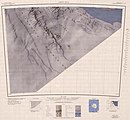|
Heritage Range
The Heritage Range is a major mountain range, 160 km (99 mi) long and 48 km (30 mi) wide, situated southward of Minnesota Glacier and forming the southern half of the Ellsworth Mountains in Antarctica. The range is complex, consisting of scattered ridges and peaks of moderate height, escarpments, hills and nunataks, with the various units of relief set off by numerous intervening glaciers.[1] The northern portion of the range was probably first sighted by Lincoln Ellsworth in the course of his trans-Antarctic flight of 23 November 1935. On 14 December 1959, the southern range was seen for the first time in a reconnaissance flight from Byrd Station, made by Edward C. Thiel, J. C. Craddock and E. S. Robinson. The team landed at a glacier on Pipe Peak, in the northwestern part of the range, on 26 December.[1][2] During the 1962–63 and 1963–64 seasons, the University of Minnesota expeditions made geologic and cartographic surveys of the range. The entire range was mapped by USGS from aerial photographs taken by the U.S. Navy, 1961–66.[1] The Heritage range was so named by US-ACAN because topographic units within the range have received names relating to the theme of American heritage.[1] Maps
FeaturesGeographical features include: Anderson MassifDouglas PeaksDunbar RidgeEdson HillsEnterprise HillsFounders PeaksSmith RidgeOther Founders Peaks featuresFrazier RidgeGifford PeaksIndependence HillsLiberty Hills (Antarctica)Meyer HillsPioneer HeightsGross HillsInferno RidgeNimbus HillsSamuel NunataksOther Nimbus Hills featuresOther Pioneer Heights featuresSoholt PeaksWatlack HillsWebers PeaksOther features
References
External links
|
||||||||||||||||||||||||




